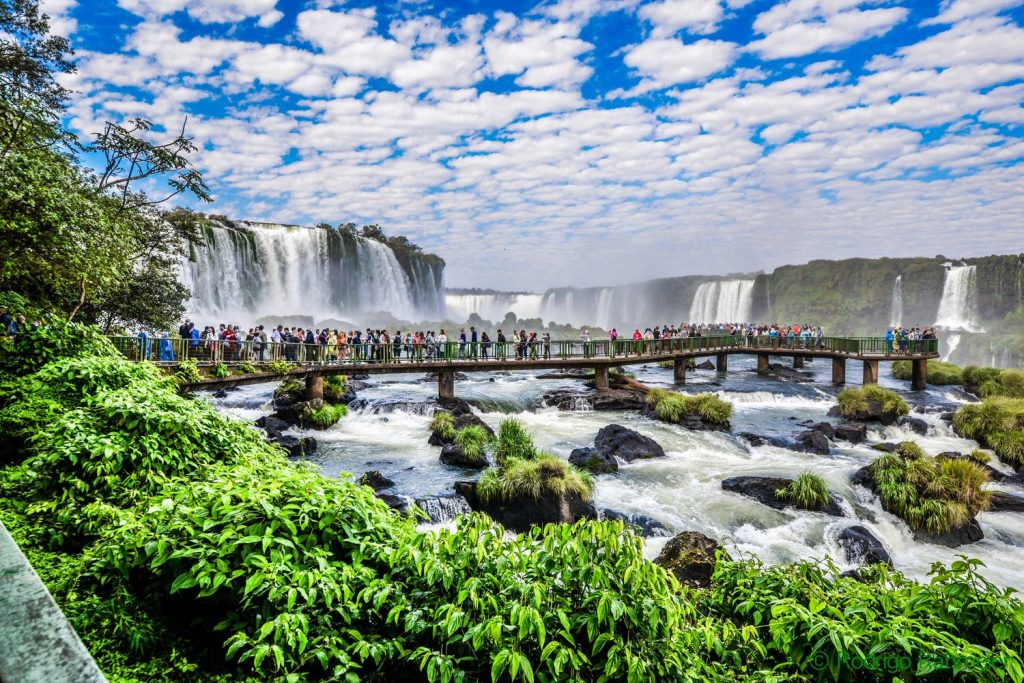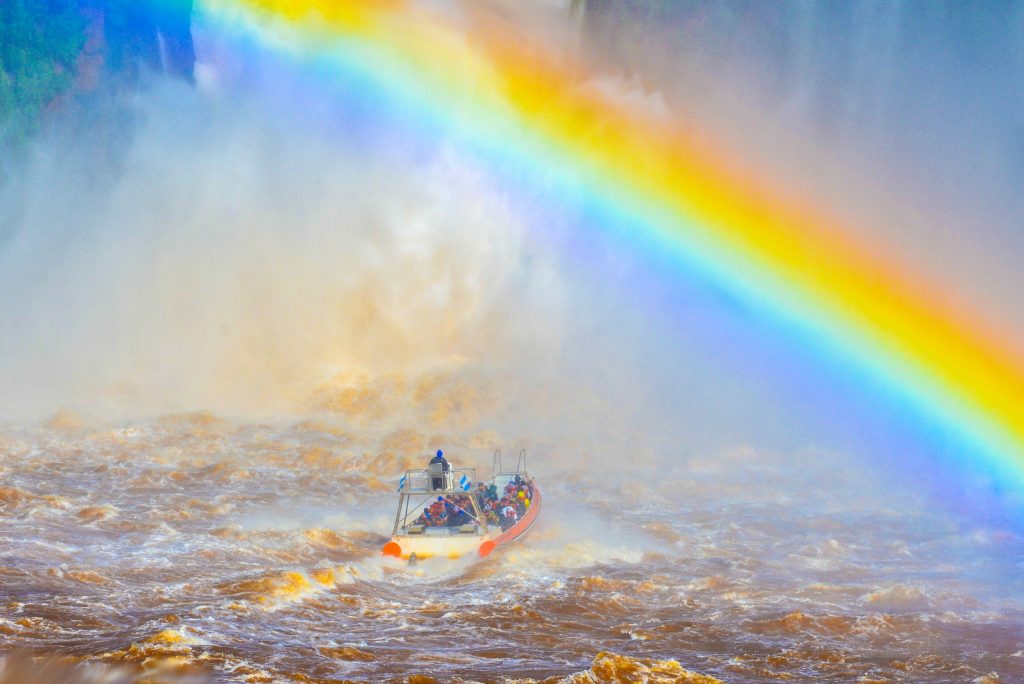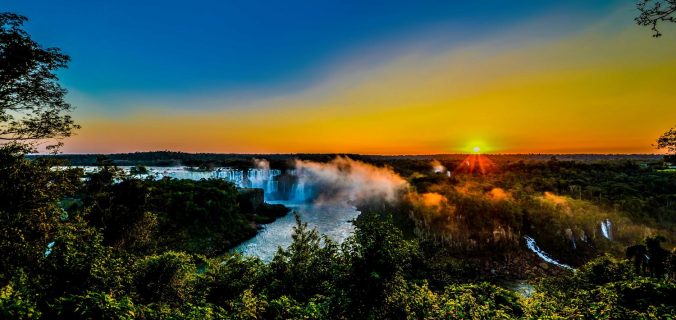Consecrated among the 7 Natural Wonders of the World, Iguazú Falls are the most visited natural attraction in the province of Misiones and one of the most impressive in Argentina and the world.
Iguazú Falls are located within the Iguazu Falls National Park of the same name, about 20 kilometers from the city of Puerto Iguazú, north of the province of Misiones, Argentina. The river that forms them, also called Iguazú, is born in the state of Paraná, in Brazil, and after traveling about 1200 kilometers through a plateau, absorbing the flow of the tributaries that it encounters on its way, it reaches a point where a Geological fault forms a rift in the plain. As if a giant shovel had sunk into the ground separating its sides.
Only in this cut, it coincides with the passage of a river.
A river that has been crossing a calm geography, without too many surprises, that little by little finds in its transit a series of jumps. And suddenly, about 80 meters of unevenness that turn into a violent sensation of vertigo: the Devil’s Throat, the main waterfall jump, combined with a constant deafening thunder that plunges into the deepest, and then meekly, emptied a few kilometers on the Paraná river.
In Guaraní language, the term Iguazú translates as Big Waters. They were discovered by European explorers in 1541, by the advanced Alvar Núñez Cabeza de Vaca. In 1984, UNESCO declared them as natural heritage of humanity and in 2011 an international contest nominated Iguazú Falls as one of the 7 Natural Wonders of the World.
One of several legends tells of the existence of a giant snake, “Boi”, which lived inside the river. To appease their ferocity, the aborigines sacrificed a lady once a year, throwing her into the waters as an offering to the beast. On one of these occasions, a brave Guarani kidnapped the chosen maiden, to save her from the traditional ritual, escaping with her in a canoe on the river.
Upon learning of the audacity, Boi went into a rage and, hunched over his back, split the course of the river, thus creating the falls and thus separating the two indigenous people.
Walking the catwalks

The visitor will find more than 270 jumps along the cliffs and islets, spread over the crescent that forms this geographical feature.
From the Visitor Center, the trails can be walked or you can choose a picturesque gas-burning train. Basically, you can see the Iguazú Falls through two circuits: one lower and one higher.
Through the Lower Circuit you reach the base of the waterfalls, and the force of the water transformed into dew or steam ends up wetting the crowd. But the experience is unique and the adventure is worth cheering up. Also from this circuit you can take a boat to the San Martín island.
In the Upper Circuit, the ride is more sedentary. Panoramic views from the walkways and viewpoints make the stay an unforgettable experience.
Throughout our visit we will be able to see the following jumps: Floriano Jump, Deodoro Jump, Benjamin Constant Jump, Union Jump, Hidden Jump, Miter Jump, Belgrano Jump, Rivadavia Jump, Three Musketeers Jump, Two Musketeers Jump, San Martin Jump, Jump Adam and Eve, Salto Bozzetti, Salto Ramirez, Salto Chico, Salto Dos Hermanos and Salto Alvar Nuñez, among others.
Within the route, leaving the Cataratas station, we reach the walkway that crosses the upper river. After walking through it, we arrived at the edge of the balcony of the Devil’s Throat, the largest waterfall of all. The feeling of imposition is incomparable, and even if we take millions of photographs from this corner, we will never be able to express with images what has been lived in this place. The flow is so great and its density so vertiginous, that one feels vulnerable in front of this particular scenario.
Wild adventure
Within the attractions of the Iguazú National Park, and for those who enjoy adventure tourism, you can access a series of slightly more active tours.
Beyond the falls and waterfalls already mentioned, the jungle that contains the Iguazú Falls offers several alternatives. A more humid and slightly cooler environment makes it conducive to the development and growth of a wide variety of flora and fauna. The natural balance means that there is a high amount of food, and consequently the fauna is also very varied. Almost 500 species of birds, around 80 of mammals, a great variety of reptiles, fish, insects and butterflies inhabit this ecosystem.
A few meters from the research center is the MACUCO Trail, a pedestrian path that crosses the thick jungle, about 3 kilometers long with varying degrees of difficulty. The walk can be done in a particular way and takes about 2 hours. At the end of the trail we will find the Arrechea waterfall.
A private provider offers a slightly bolder alternative. Going out in an open 4×4 mobile, we will travel about 8 kilometers inside the jungle, to reach the banks of the lower river.

Semi-rigid rubber boats with powerful outboard motors will be waiting for us to go up the river. Bypassing the rapids we will arrive at the foot of the falls and in this way we will do our baptism in the Iguazú Falls. The bow of these semi-rigid will approach such a point of almost getting inside the curtain of the waterfalls.
You can also board a gomón oar in the upper Iguazú, which will allow us to take a closer look at the flora and fauna that make up this delta. With a little luck we will be able to spot water turtles and alligators sunning themselves on the coast.
In short, Iguazú is a very particular environment. Not surprisingly, Horacio Quiroga was inspired by these Argentine corners to write his “Tales from the Jungle”.

